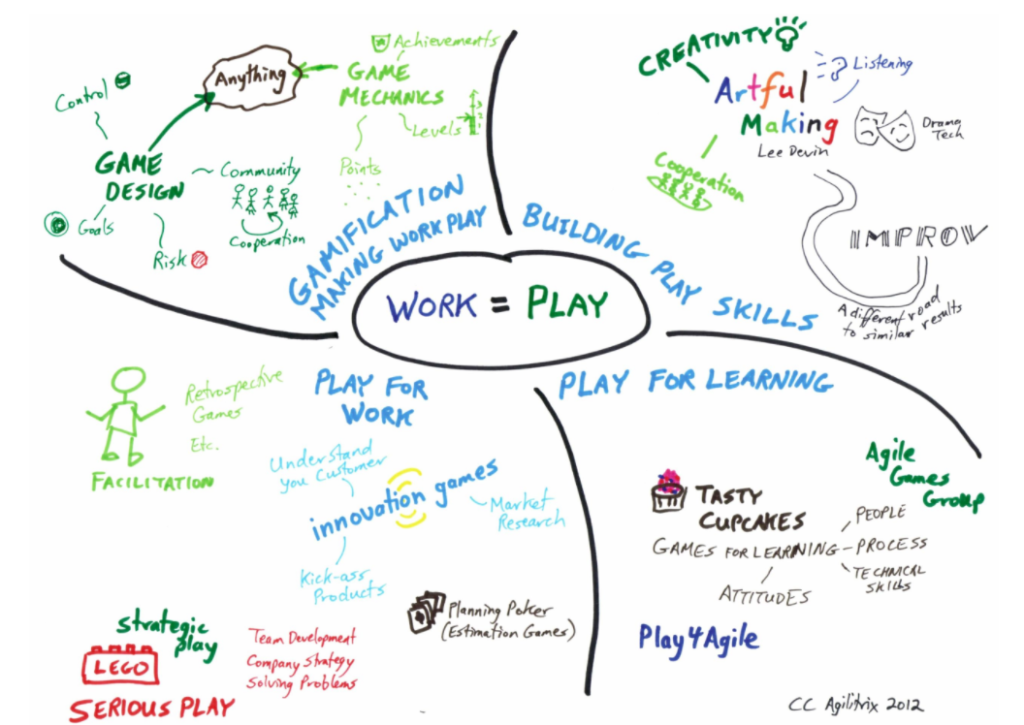And now for something totally out of the ordinary… how to hack your culture with Agile games to unlock high performance. We are not playing around here, this is only for those who are serious about creating success. Now, for a lot of people coming from a traditional work environment, this sounds kind of crazy. So what’s going on?
As a certified enterprise coach, I spent 2011 or 2012 focused on games. I explored how to create games, facilitate games, how to use games for education and how to use games to create results. I became a certified facilitator in Innovation Games and Lego Serious Play. What I discovered is that Agile Games are actually a profound technology for creating high performance.
Agile Games and High Performance
Why are Agile games (and play more generally) so important for creating high performance? That’s a good question. It turns out that everything we do depends on our inner state of being. If you think about a human being in a traditional work environment – under pressure, stressed, and overwhelmed by deadlines – they’re in a contracted state. Their ability to create and be creative is diminished. Games and play give us the ability to access the full potential of a human being by getting them to open up and have fun.

Play puts people into an open, expansive, high vibrational state where they can access their full intelligence. Games prompt psychological safety. When a person is safe it opens up the quantum field, so they can access creative ideas through the universal thought series that we’re all connected to. That’s why often in meetings, we have things like icebreakers to open people up, to get people connected, and help them feel psychologically safe.
Why Agile Games Are Effective
Why are Agile games and play so effective? First, for a game to be happening, it has to meet certain criteria:
- It has to be voluntary, meaning people have to opt in to do it.
- There have to be clear boundaries – a clear set of rules that say, “This is the bounding box of the game.” That’s what makes the game fun.
- There is some sort of goal or outcome that people are seeking. They want to win the game.
When we have these magical ingredients, boom! People open up.

It could be that being in your work environment is like playing all the time. There are Nerf guns on the table, people throw Frisbees around, and people bring in their pets. It’s just a really hip, casual, great work environment where anyone can say anything and people are open to all ideas. Most work environments are not this open and free.
Most of us have either fully constrained or partly constrained work environments. For us, play and games are a great way to break out of the constraints of our work environment, to elevate ourselves for an hour or two to support and operate at our best. When we do that and experience the positive energy that comes with games, it opens up to possibility and innovation, not just for that session, but for the rest of the day and week. That’s why play and games are so powerful.

Stuart Brown wrote a book called, “Play“. He says, “The opposite of play is not work. It’s death.” The opposite of play is death. When we think about traditional organizational structures, they’re in a state of decay and death. Agile games and play open us up to fun, the field of possibility, the full potential of a human being. Games begin to build a culture of psychological safety and high performance. That’s why they’re so powerful.
How Can We Use Play at Work?
How can we use Agile games to increase our ROI and get high-performance outcomes?
First, it’s vital to follow the most important rule: it’s always about getting work done. The goal of play in the workplace is to achieve an objective. Play and games are the means by which we achieve those objectives extraordinarily well.
It’s very important to set the stage when introducing an activity. “Hey, we’re here to achieve this objective. The best way we can do it is by playing this game.” That way, people are focused on the work outcome. What this does is normalize play at work.
This diagram talks about four different ways we can use play:
- Play for Learning. For understanding new information or learning about team dynamics.
- Play for Work. Meant for achieving objectives at work.
- Work Gamification. Building play into the structure of our workplace.
- Building Play Skills. Cultivating skills like creativity.

Play for Learning
In our leadership training, we use play all the time, with activities, so people can engage with the material. Simply getting people to sort a list of concepts or move cards around on a table, for example. Any of these simple activities where they’re using the concepts in the game, get them to learn the concept at a much deeper level. Instead of having a lecturer speak about information, putting people through a simulation helps people learn concepts in a much deeper way and understand the connections between things.
Play for Work
Play for Work is one of my favorites. What this is about is using encapsulated technologies of play to get work done. In the Agile World, famous ones are things like planning poker cards.
In our SELF™ leadership training courses, we use decision cards. It is used as a guide/gamified way to make the choice of, “Whose decision is it?”, this opens up the communication on decision making.
“Ah, what card should I play?” “What card will somebody else play?” “I wonder what they’re thinking.” It’s like playing a game of poker or something, where we’re using the best information available and making a guess. It takes some of the seriousness out of decision-making so we can open up to the possibility of what may unfold.

It also reveals the power that lays behind the control of decisions. And can reduce the frustration and disappointments teams find when hitting the invisible fences around self-organizing, autonomous teams.
A Powerful Way to Listen to Your System
I am also trained in some very specific technologies, such as Innovation Games and Lego Serious Play. Lego is all about, how do we use Lego to get emotions on the table, to solve those really challenging problems? Innovation Games are really about understanding, “What do our customers really want? How do we make sure we’re building products that they really want?”
Now, it turns out we all have customers. If you’re an IT Department, it could be about, “What do the customers that you’re building software for really want?” If you’re the head of an organization or a team, you can say, “The people who report to me, they’re my customers, I’m trying to look after them – what do they really want?”
These games are also a really powerful way to listen to the system to understand, what does this group of people really want? So it’s a very powerful way to use play to get people to open up, to share their ideas.
Jumping back to Lego Serious Play, I heard someone say, “Oh my gosh, I can’t believe I just said that. I didn’t even know that was in me.” Agile games are a way, through play, to pull information, because what we’re actually doing is we’re getting people to use a different part of their brain – not just the frontal cortex, but their whole brain – to access the full intelligence of a human being.

Gamification: Making Work Play
Gamification. I’m not talking about superficial gamification, where you give people badges and points. That is, in my opinion, a complete waste of time. I’m talking about really gamifying the core of what is happening at the organizational level, in a healthy and productive way.
What does this really mean? It means creating a space that enables positive behaviors using game mechanics.
When we think about a team or an organizational group, it’s a complex system. What we want to do is use game mechanics to tilt the playing field, so people go in the direction that serves the organization, and it makes it harder for them to go in directions that are unhelpful.
Gamification in Practice
That’s all theory – let’s make this very practical. Let’s imagine that learning is the bottleneck (this is probably true in most teams and most organizations). We can gamify this by making people’s skill levels visible, no matter how good or bad they are, and celebrating people advancing their knowledge. Really celebrating people learning and developing, not in a shallow way, but in a genuine, human way.

We can encourage that kind of behavior in the environment. Make it more popular. Make people go, “Oh, it is a good thing for me to learn and grow. And it’s good for my team members and my organization.” What’s even more valuable is to really celebrate those people who are doing the mentoring, so we can highlight those people who are building other leaders around them. These are some examples of how we can use game mechanics to align self-interest with the interests of the organizational system and by doing so, create a win-win.
That’s what real gamification of an organizational or team system is all about. Not surface-level things like badges and levels and all that stuff, because nobody really cares about that. What people care is about being seen, being recognized, and being able to make a difference.
Building Play Skills
I’m really grateful that I’ve had a lineage of very, very capable teachers. What I realized is that no matter how many games we’ve played, no matter how many sports teams we’ve been on, there’s room for us to learn how to play together. To learn how to be a better team member. The places I’ve learned the most from are Lee Devin’s Artful Making or Learning from Improv.
Let’s just take Improv as an example. In an Improv situation, everybody’s on stage. And the number one rule is, everything that somebody gives you is a gift; you’re not allowed to refuse a gift on stage. You’ve just got to flow with it. The second rule is, focus on how you can make other people look good. How can I help my team members succeed?

When everyone follows those two rules, amazingness happens, because we are no longer blocking ideas. We’re no longer thinking we’re the smartest person in the room and arguing about stuff. We’re just going along with what we’re presented with.
When we’re so focused, not on “How do I be a winner,” but on, “How do we make an amazing set?” If this is one’s focus, we all will perform better. Success begins with the shift from “I” to “we”, from being attached to my idea to accepting somebody else’s idea. Yet this requires us to work through the default dysfunctional behaviors of our egoic system.
In play for learning, we’re trying to learn concepts and ideas, and get information. In building play skills, we’re learning how to overcome our ego, to be a better collaborator, which means understanding our own limitations and working through them. So we could really call this leadership development – Game and play develop the leader within each of us.
My Favorite Agile Games
There are fantastic websites like Tasty Cupcakes, which have tons and tons of Agile Games. There are conferences like Play for Agile, all about how to use play to help people learn. For now, I’ll share my favorite Agile games.
Play for Learning
The following games are those I’ve found to be the most fun and effective. For a more in-depth look at play for learning, check out this article.
Henrik Kniberg’s Name Game. This multitasking name game is very useful for people to understand the Agile/Lean concept of limiting the amount of work in progress (WIP).
The XP Game. The XP Game is a very powerful way to teach people the fundamental principles of Agile Software Development, the role of the customer, the role of the team and the developers, and what it really means to be adaptable. And it’s fun as all get out. I also have a scrum variant of it. There is also a scrum variant of The XP Game.

Building Skills
“Yes, And!” The game is called, “Yes, And!” In this game, we replaced the words “Yes, but” and we experienced what that’s like and then we change it to “Yes, and.”
Say Yes. There’s this famous movie with Jim Carrey called, “Yes Man.” In the movie, he has to say “yes,” no matter what’s going on. So what this game does is, when you make a commitment to yourself to say yes for an entire day, you’ll see all the places where you’re actually a “no.” Even if you don’t say yes, what it’ll do is it’ll highlight to you where you’re not responding to change. Where you’re not ready to go with what’s happening around you. Where you are attached to your ideas of what should happen. We’re not saying that you should never take a position or a stand, but we do it far too often. And when we’re really good at play, we can do just about anything. This game also helps us practice a very advanced leadership practice called “Surrender” by helping us learn to go with the flow.
Play for Work
Speed Boat. A very simple, easy-to-play game is called “Speed Boat,” which is part of Innovation Games, and it’s a very simple idea. We just put a big flip chart up. We draw a simple image and say, “This is the boat. This represents our team, our group, but there are all these anchors slowing us down. Let’s put up a sticky note for every anchor slowing our boat down.” It’s a really beautiful way to understand what challenges a team or group is facing.
Fist of Five Another game that fits under “play for work” is called “Fist of Five.” This one is about making decisions. When someone says, “Hey, I’ve got an idea. I propose we do X, Y, Z. Let’s vote.” And we say, “Where’s everyone on a scale of zero to five?” just to get a quick read. People put up the number of fingers that correspond to how much they like the idea. That’s a very practical gamification of making decisions as a team.

Gamification in Practice
Turn anything into a game. I wrote a post called “How to Create Your Own Game with Anything,” which is a little tutorial on how to create your own game. Below we give a specific, concrete example of how to make a game.
Metagame for Learning. All you do is, for each concept that’s there, it could be for culture models, leadership models, any sort of data – usually between four and 10 items. You can just put each item on one card. Then you can make up an activity to get the participants to organize the cards.
It could be any activity. Pick the top three. Sort them from most important to least important. Any kind of random activity you give people will help them process the information and learn it better. This kind of Meta Learning Game is a powerful tool for learning, and I use it all the time in my training.
Agile Games are for Performance
Agile is about people. And Agile games are about revitalizing, energizing, and bringing out the best in people. And this is the root of high-performance teams and organizations. If you’re not yet ready to say yes to games and play, it means your environment is not really ready to say “Yes” to Agile and high performance.
The secret is to carefully inject games to achieve results. Play on!



